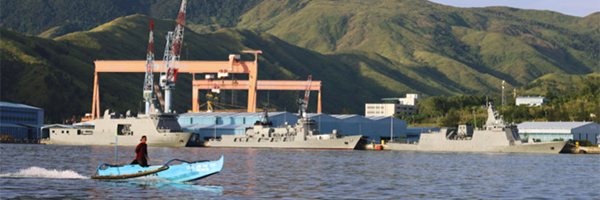U.S. Military Poised to Return to Subic Bay, Counter China’s Presence
The former U.S. Naval Base Subic Bay, which faces the South China Sea, has become a bustling free port that employs about 150,000 locals, administered by the Subic Bay Metropolitan Authority.
Manila and Washington have been in negotiations over setting up five more locations in the Asian country to build U.S. military facilities and preposition weapons under the Enhanced Defense Cooperation Agreement.
Rolen Paulino, chairman of the SBMA, told Kyodo News on Wednesday that he would be “very surprised” if Subic Bay does not become an EDCA site, as “during war, time is of the essence,” a day before the 30th anniversary of the U.S. Navy’s departure from the harbor that it had controlled for nearly 94 years.
A series of events were held Thursday at the free port to mark the 30th Founding Anniversary of the SBMA, including a public display of civilian airplanes and a Philippine Navy helicopter at the Subic airport which is now being repurposed for surveillance and aviation training.
Signed in 2014, the EDCA is likely to continue beyond its 10-year period, as indicated by the United States’ renewed interest in establishing new bases in the Philippines and fresh funding for upgrading existing EDCA sites.
Paulino said tensions over the Taiwan Strait and the growing animosity between the United States and China are causes for concern.
A former mayor of the adjacent Olongapo City, Paulino would prefer that his government maintains a defense alliance with the United States, adding that most Olongapo residents are “pro-Americans” given the very long time they have lived alongside U.S. servicemen.
On Nov. 9, U.S. Ambassador to the Philippines Mary Kay Carlson visited Subic Bay and the shipyard that U.S. private firm Cerberus Capital Management LP acquired this year. The Philippine Navy has also begun occupying part of the shipyard as its new naval base.
Paulino believes Carlson’s visit amplifies the importance of Subic Bay to the United States. A senior Philippine official said two Chinese firms had wanted to take control of the shipyard, but the United States had stepped in.
The Philippines and China have overlapping claims in the South China Sea, a mineral-rich and vital shipping lane through which $3 trillion worth of trade passes annually.
As ordered by Philippine President Ferdinand Marcos Jr., Manila on Thursday wrote a note verbale to China, seeking “clarification” on the Nov. 20 encounter between the Philippine Navy and the Chinese Coast Guard near the Philippine-occupied island of Thitu, a maritime feature in the contested waters.
Philippine authorities have said the Chinese coast guard “forcefully” retrieved debris resembling a Chinese rocket launched in October.
A Chinese Coast Guard rigid hull inflatable boat approached a Philippine naval ship towing the debris to the island and twice attempted to block the vessel’s way before the Chinese boat’s crew cut the towing line and took the object.
*

 Kyodo News, Asia-Pacific Research, November 25, 2022 — The U.S. military will likely return to Subic Bay 30 years after relinquishing what was once their largest military base in Asia due to concerns over China’s increasing maritime assertiveness, a top official of the local body overseeing the free port zone said.
Kyodo News, Asia-Pacific Research, November 25, 2022 — The U.S. military will likely return to Subic Bay 30 years after relinquishing what was once their largest military base in Asia due to concerns over China’s increasing maritime assertiveness, a top official of the local body overseeing the free port zone said.
